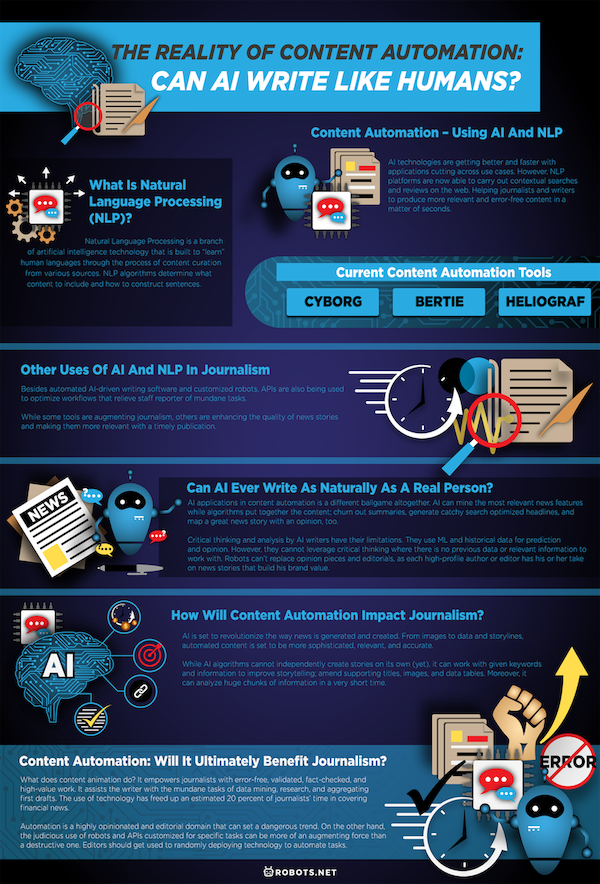Welcome to the world of content automation! This is one of the latest applications of AI that will shake up the world.
Content Automation – Using AI And NLP
AI technologies are getting better and faster with applications cutting across use cases. For interactive communication, writers and journalists are using Natural Language Processing (NLP) because of its ability to decode language and texts. They have initially been used in chatbot conversations and read out loud text-to-speech systems. However, NLP platforms are now able to carry out contextual searches and reviews on the web. Moreover, they can transform both into summarized stories. In addition to this, it is helping journalists and writers to produce more relevant and error-free content in a matter of seconds. There are improvements in NLP technology and advanced NLP software. They help in the transformation of structured data into plain long-form content. These are automated Natural Language Generation (NLG) systems that decode data and store textual information from multiple sources in real-time. Furthermore, they also transfer the information into a readable format. Like data cleansing, the NLG system eliminates ambiguous or flawed user input and translates it into textual format.
What Is Natural Language Processing (NLP)?
NLP understands human language. Additionally, Machine Learning (ML) repeatedly learns during the process of research and content curation from various sources. Moreover, the system determines what content to include, how to structure the document, aggregate text, and merge similar sentences to improve readability. In addition to this, it uses a rhetorical choice of words for naturalness and follows the rules of syntax to write a grammatically correct article! The advantages of deploying the NLP technique for article generation has seen publishers creating their very own writing robots. Furthermore, they influence computerized writing software for automated news and article generation. So, with the digital disruption of content creation, we now have robot generated news stories and journalistic pieces that go beyond rewriting news articles to opinion pieces. From creating summarized news stories to opinion pieces, the AI writing software has disrupted journalism with content automation like never before. With advances in algorithmic techniques, is it possible to perfect AI and NLP in a way that people will think that a real human has written a robot-crafted article? Well, even as we speak, it is happening all over the world!
Current Content Automation Tools
Bloomberg was an early adopter of automated content. They used their dedicated program, Cyborg, to produce articles in their financial section. Much like business reporting, the ‘robot journalist’ reads and analyzes financial reports to churn out news stories. This is one of the best use cases of content automation. This is because it leaves no chance for human errors of interpretation. Consider a traditional set-up of a newsroom when the journalist is running behind schedule. While she is perusing through a lot of data, her editor has to wait for her draft. Enter robot journalists. Instant curation of financial news from across the world and different timelines, to the analysis of tons of reports in seconds, and translation into appropriate content, AI can do it all for the journalist. What’s more? You can get much more content done, with no room for errors, at a fraction of resources, and in real-time. Happy times for the editor, forever under pressure to deliver ‘breaking news’ and justify staff costs to the board. Forbes, too, makes use of the AI publishing platform Bertie. It is an essential content management system (CMS) tool that recommends article topics for contributors and headlines based on sentiment analysis of previous posts. The Washington Post’s adoption of the robot Heliograf set a trend in content automation in 2016. It produced 850 news stories on the 2016 Presidential Elections. Taking a leaf out of the Robotic Process Automation (RPA) use in algorithmic trading, Heliograf leverages AI to detect trends in finance. For automated real-time news alerts, they are crunching a huge amount of information filtering in from news services and world markets.
Other Uses Of AI And NLP In Journalism
Besides automated AI-driven writing software and customized robots, APIs are also being used to optimize workflows that relieve staff reporter of mundane tasks. BBC uses news content and aggregator API, The Juicer. Washington Post uses the Knowledge Map in addition to its robot Heliograf, to correlate media sources. New York Times deploys the editor application in its Research and Development Lab to crunch data faster. Reuter News Agency makes use of the News Tracer to be on the top of breaking news, automating routine tasks of content research. Another News Agency, the Associated Press, began using AI as early as 2013 to extract data and produce sports and earnings reports. Today, it uses the NewsWhip to be ahead of trending news stories on social media. These are a few examples of how media giants and news agencies are deploying AI for bionic content. While some tools are augmenting journalism, others are enhancing the quality of news stories and making them more relevant with a timely publication.
Can AI Ever Write As Naturally As A Real Person?
Digital transformation has invaded every industry and streamlined work processes. However, most people wouldn’t have imagined that it has already made an impact on journalism. Even though it is cool to have a chatbot address your product queries, having AI decide what content you read with your morning cup of tea may be a mind-boggling experience. AI applications in content automation is a different ballgame altogether. AI can mine the most relevant news features while algorithms put together the content; churn out summaries, generate catchy search optimized headlines, and map a great news story with an opinion, too. Does the rise of content automation mean the takeover of journalism jobs and newsrooms? That depends largely on whether the AI writer and robot author can write as naturally as humans do. Just like in care-giving, robots cannot fully simulate the human touch. Moreover, the robot journalist cannot ask follow-up questions on the fly in a face-to-face interview. Neither can creativity and humor be replicated by a robot journalist. Critical thinking and analysis by AI writers have their limitations. They use ML and historical data for prediction and opinion. However, they cannot leverage critical thinking where there is no previous data or relevant information to work with. Robots can’t replace opinion pieces and editorials, as each high-profile author or editor has his or her take on news stories that build his brand value.
How Will Content Automation Impact Journalism?
Technology has always disrupted the way we live and work. In content automation, AI is set to revolutionize the way news is generated and created. From images to data and storylines, automated content is set to be more sophisticated, relevant, and accurate. While AI algorithms cannot independently create stories on its own (yet), it can work with given keywords and information to improve storytelling; amend supporting titles, images, and data tables. Moreover, it can analyze huge chunks of information in a very short time. Robots can act as assistants and researchers. They can gather the necessary information and help with optimized headlines. Routine tasks can be automated, leaving the journalist free for live reporting, investigative news coverage, and face-to-face interviews. Content automation is most significant in the realm of data-driven stories, financial and sports news, where real-time news generation makes the difference in profit for a publisher.
Content Automation: Will It Ultimately Benefit Journalism?
What does content automation do? It empowers journalists with error-free, validated, fact-checked, and high-value work. It assists the writer with the mundane tasks of data mining, research, and aggregating first drafts. The use of technology has freed up an estimated 20 percent of journalists’ time in covering financial news. Automation is a highly opinionated and editorial domain that can set a dangerous trend. On the other hand, the judicious use of robots and APIs customized for specific tasks can be more of an augmenting force than a destructive one. Editors should get used to randomly deploying technology to automate tasks.
Final Thoughts On AI Content Automation
The overarching narrative builds around AI robots taking away the jobs of journalists, which is at best, a myth. Automation cannot be a job-killer, but raise the bar further with highly specialized, factual stories in real-time. AI holds an unlimited potential of supporting the content automation industry. It tells better news stories that add momentum to a 24/7 connected ecosystem hungry for instant news.

